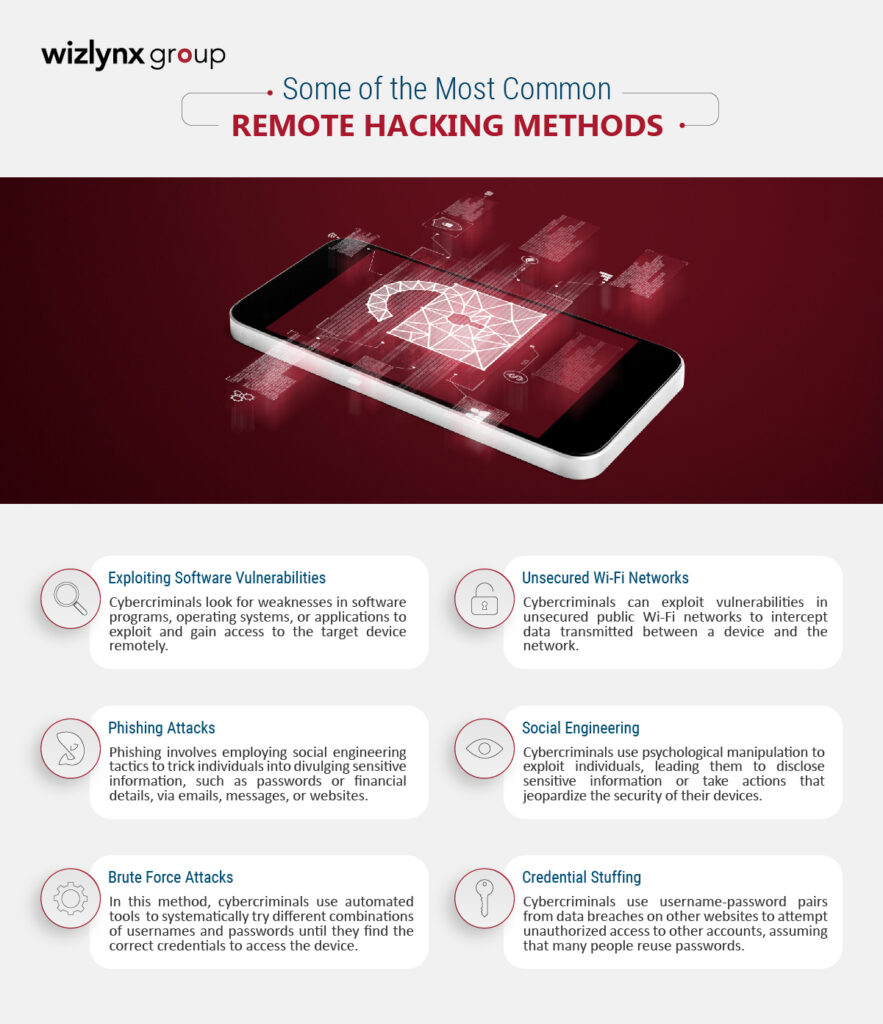
As our society becomes increasingly digitalized, mobile devices inherently became an essential part of our daily lives. From staying connected with loved ones to conducting business transactions, mobile devices are a critical component of modern-day communication. However, with this increased reliance on mobile devices comes an increased risk of cyber threats, including remote hacking. Remote hacking is a form of cyberattack in which cybercriminals gain unauthorized access to a device or network remotely. This type of attack can be carried out in numerous ways. Exploiting system vulnerabilities and weak passwords, or using social engineering techniques, are some of the most common techniques.
In this article, we will explore the many ways in which cybercriminals can remotely infiltrate your devices, what you can do to protect yourself and why is this significant concern for individuals and businesses alike.
The Growing Risk of Remote Hacking
A study conducted by Check Point Software revealed alarming statistics regarding mobile threats faced by organizations during 2020. Astonishingly, 97% of organizations encountered mobile threats employing diverse attack vectors. Furthermore, an unsettling 46% of organizations reported at least one employee falling victim to the perils of downloading a malicious mobile application. Among the multitude of techniques employed by cybercriminals, phishing attacks stand out as one of the most prevalent methods for gaining unauthorized remote access to personal devices.
Phishing is a cunning social engineering technique utilized by hackers to deceive unsuspecting individuals into divulging sensitive information, such as passwords or financial details. They target every level of an organization. This nefarious scheme can be executed through various channels, including email, SMS, and social media platforms. Once the cybercriminal successfully acquires the target’s information, they gain the ability to remotely infiltrate and compromise your device, posing a significant threat to your privacy and security.
Understanding Remote Hacking Techniques
These networks, lacking the necessary security measures, present a common vulnerability that cybercriminals can exploit to gain unauthorized access to mobile devices. Interestingly, a startling statistic reveals that 60% of consumers consider using public Wi-Fi riskier than using a public restroom—a testament to the perceived dangers associated with these networks. Despite this awareness, the Norton Cybersecurity Insights Report uncovers a disconcerting truth: people are not consistently practicing safe security habits online.
Connecting to an unsecured Wi-Fi network exposes your device to potential attacks. Cybercriminals can intercept your data and gain entry to your device through various means, such as executing man-in-the-middle attacks or exploiting vulnerabilities within your device’s software. In addition to phishing and Wi-Fi attacks, hackers can exploit weaknesses in your device’s software or hardware to gain remote access to your phone. Neglecting to regularly update your device’s operating system and applications leaves it susceptible to such breaches. Hackers are quick to seize upon these vulnerabilities, capitalizing on their existence to remotely compromise your device’s security.
Protecting Yourself and Your Organization
So, what can you do to protect yourself from remote hacking? Firstly, it is essential to practice good cybersecurity hygiene. This includes regularly updating your device’s operating system and apps, using strong and unique passwords, and avoiding connecting to unsecured Wi-Fi networks. You should also be cautious when clicking on links or downloading attachments from unknown sources, and always verify the legitimacy of the sender.
Secondly, it is crucial to invest in robust security measures. Comprehensive cybersecurity solutions like the ones we offer can help protect your device from remote attacks by detecting and preventing unauthorized access, and discovering vulnerabilities.
Mobile Devices: A Gateway for Potential Threats
Remote hacking is a real and a significant threat that can have devastating consequences, especially when mobile devices from members of your organization or business can potentially become compromised. If an employee’s mobile device is compromised, it can serve as a gateway for cybercriminals to infiltrate your organization’s network and access sensitive data. This is particularly concerning when employees use their personal devices for work purposes or when they connect to the organization’s network remotely. Security eMagazine shared Trend Micro’s Head in the Clouds study conducted an extensive survey involving over 13,000 remote workers across 27 countries to gain insights into the habits of distributed workforces during the pandemic.
The study revealed that a concerning 39% of workers utilize personal devices to access corporate data, often through cloud-hosted services and applications. These personal smartphones, tablets, and laptops may lack the same level of security as their corporate counterparts and are vulnerable to insecure Internet of Things (IoT) apps and devices on home networks. Alarmingly, more than one-third (36%) of remote workers surveyed did not have basic password protection on all personal devices. These Bring Your Own Device (BYOD) statistics indicate the need for increased awareness and security measures to protect against potential breaches. When employees fail to adequately protect their devices, it can put the entire organization at risk! To mitigate this risk, organizations should establish clear policies and guidelines for mobile device usage, provide employees with training on how to secure their devices, and implement a comprehensive mobile device management solution.

Striking a Balance: BYOD Policies in Modern Workplaces
Furthermore, an unsettling 17% of workers admitted to using personal devices for work without informing the IT department, according to Zippia’s 2023 research summary on BYOD trends in the workplace. This practice, although prevalent, creates additional cyber risks for the business as it circumvents IT’s oversight and control. Companies must implement clear policies and educate employees on the importance of reporting the use of personal devices for work to ensure proper security measures are in place.
While leveraging personal devices can provide flexibility and cost savings, it is essential for organizations to establish comprehensive security protocols to mitigate the associated risks. This includes enforcing strong password policies, implementing encryption, and regularly updating security software. The proliferation of personal devices at work has become the new normal, with the number of organizations adopting BYOD policies steadily increasing over the years. According to a study conducted by Oxford Economics for Samsung last year, mobile devices now play an integral role in the business processes of 75% of companies.
Surprisingly, as mentioned in Zippia’s 26 Surprising BYOD Statistics [2023], only 17% of employers choose to provide corporate phones to their entire staff, while the rest allow varying degrees of personal device usage in the workplace. This shift reflects the evolving dynamics of the modern workplace and highlights the need for organizations to adapt their security measures accordingly. By implementing strong security protocols and educating employees about the risks associated with personal device usage, organizations can strike a balance between productivity and data protection in today’s digital landscape.
Taking Action: Safeguard Your Digital Assets Today
Fortunately, at wizlynx group, we offer all these solutions and more. As a leading cybersecurity company, we encourage individuals and businesses to take proactive steps to protect themselves from these types of attacks. Practice good cybersecurity hygiene and invest in robust security measures. By doing so, your organizations can reduce the risk of remote hacking and protect their sensitive data from these and other cyber threats.
Leave No Stone Unturned! Protect your business and secure your future. Reach out to us now for a comprehensive cybersecurity solution tailored to YOUR specific needs. Together, we can help fortify your defenses and ensure a safer digital environment.





Remarkable! It’s in fact an awesome post, I now have a clearer idea about remote hacking from his piece of writing.
We’re thrilled to hear that you found our post on remote hacking helpful and informative. If you have any more questions or need further insights, feel free to reach out to us. Your feedback is greatly appreciated!
Good way of explaining, and pleasant reading!
Thank you! We’re delighted to hear that you found our explanation both informative and engaging. Your cybersecurity awareness is important to us!
May I say how comforting it is to find someone who truly comprehends what they’re discussing? You certainly have a knack for taking complex issues and making them more accessible. It’s crucial for more people to take notice and appreciate this perspective.
Thank you for your kind words. Our mission at wizlynx group is to simplify complex cybersecurity topics. We’re delighted to see you appreciate our efforts, and we encourage you to invite more people to read our blog articles and stay informed about these important issues.
Comments are closed.